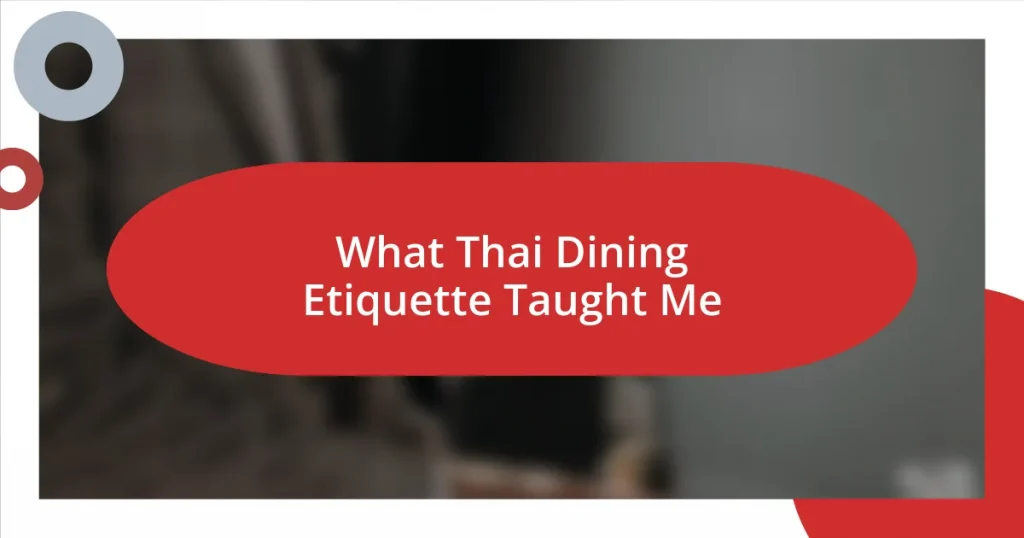Key takeaways:
- Thai dining emphasizes family-style sharing, creating a sense of community and connection among diners.
- Respect and etiquette play a crucial role, such as serving elders first and using utensils properly (fork for pushing food, spoon for eating).
- Gestures of gratitude, like saying “khob khun” (thank you) and the “wai,” enhance relationships and show appreciation for the meal and those who prepared it.
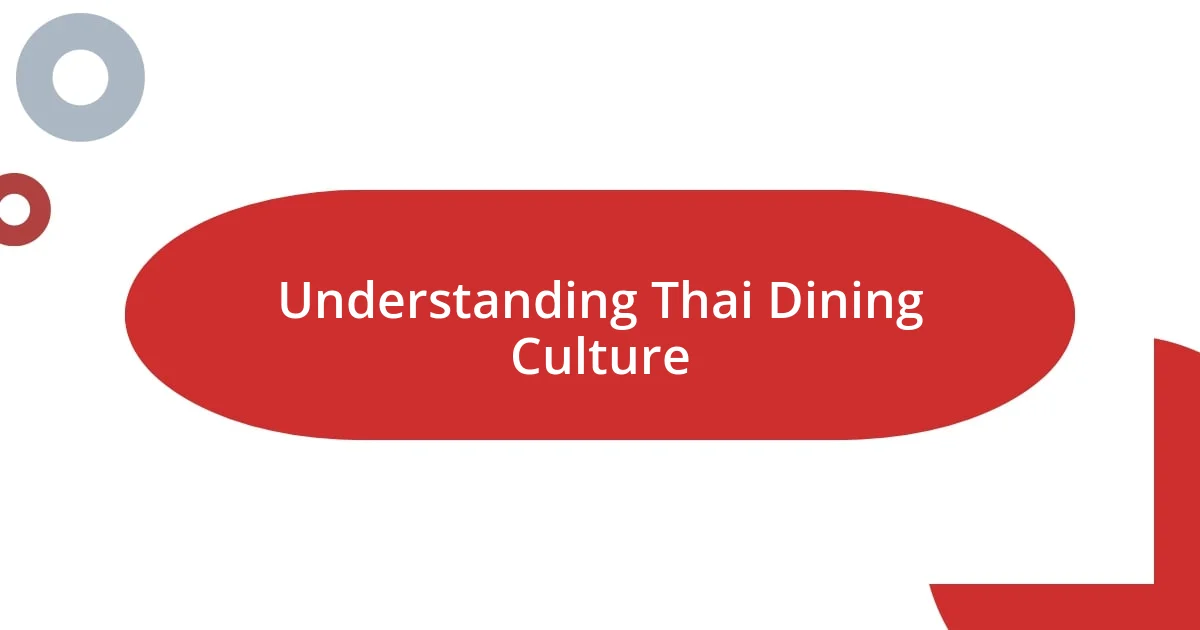
Understanding Thai Dining Culture
Thai dining culture is beautifully intertwined with respect, family, and a sense of community. I remember vividly the first time I joined a Thai family for dinner; the atmosphere was warm, filled with laughter and the aroma of spices wafting through the air. Isn’t it fascinating how food can bring people together in such a meaningful way?
In Thailand, meals are often served family-style, encouraging sharing and connection among diners. I still recall the joy of passing around dishes, each topped with fresh herbs and bright colors, and how it felt to contribute to the collective feast. It made me realize that dining is more than just eating; it’s about nurturing relationships and creating a joyful experience.
Additionally, there are subtle nuances in etiquette that enhance the dining experience, like the importance of using both hands when receiving food. This gesture of respect sparked my curiosity—why is it so significant? It’s these small practices that, when embraced, foster a deeper appreciation for the culture and the people who share it with you.
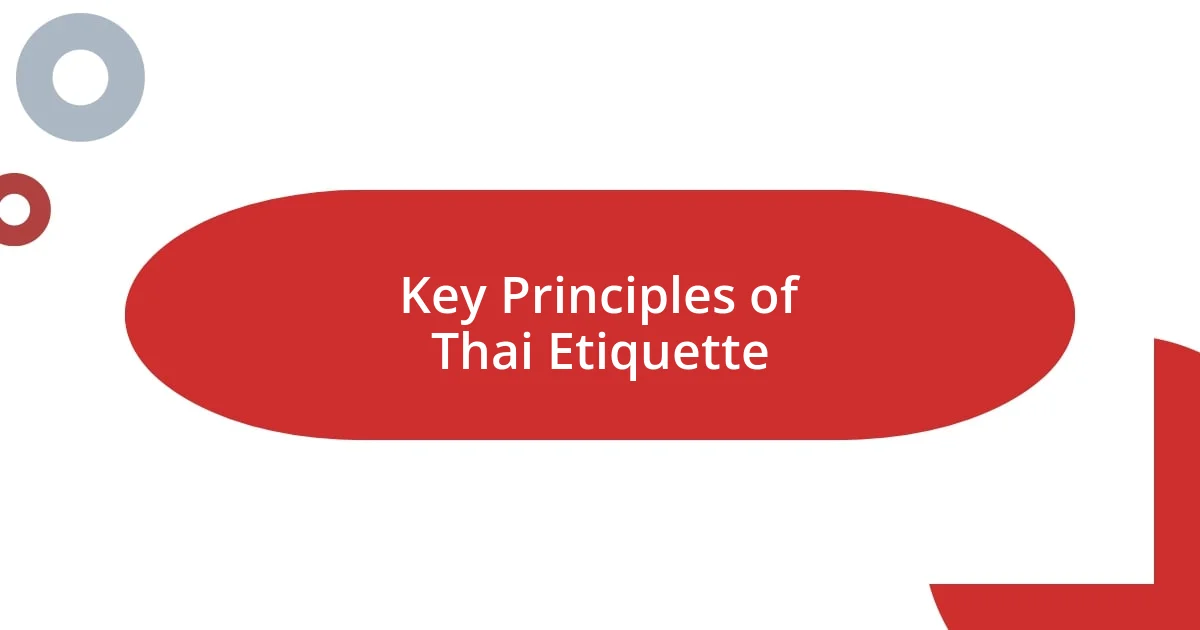
Key Principles of Thai Etiquette
The key principles of Thai etiquette revolve around respect and harmony. I’ll never forget the first time I was introduced to the concept of “sawadee,” which means greeting someone with a slight bow and hands in a prayer-like position. It felt so warm and inviting, setting a tone of mutual respect before we even sat down to eat. This deep-rooted practice reflects the fundamental belief in honoring one another’s presence, creating a serene dining atmosphere where everyone feels valued.
Here are some essential principles of Thai dining etiquette:
- Family-Style Sharing: Dishes are placed in the center, promoting communal eating and connection.
- One Spoon, One Fork: Using a spoon for eating and a fork for pushing food onto the spoon is customary, which I found uniquely elegant.
- Respect for Elders: Always serve the oldest person first, a practice that highlights the importance of family hierarchy.
- Crossing Your Legs: It’s considered impolite to sit with your legs crossed, as this can signify disrespect.
- Finishing Your Plate: While it’s often polite to leave a bit of food, finishing a meal indicates appreciation.
These principles not only shape the dining experience but also encourage a deeper, more respectful interaction with those around us.
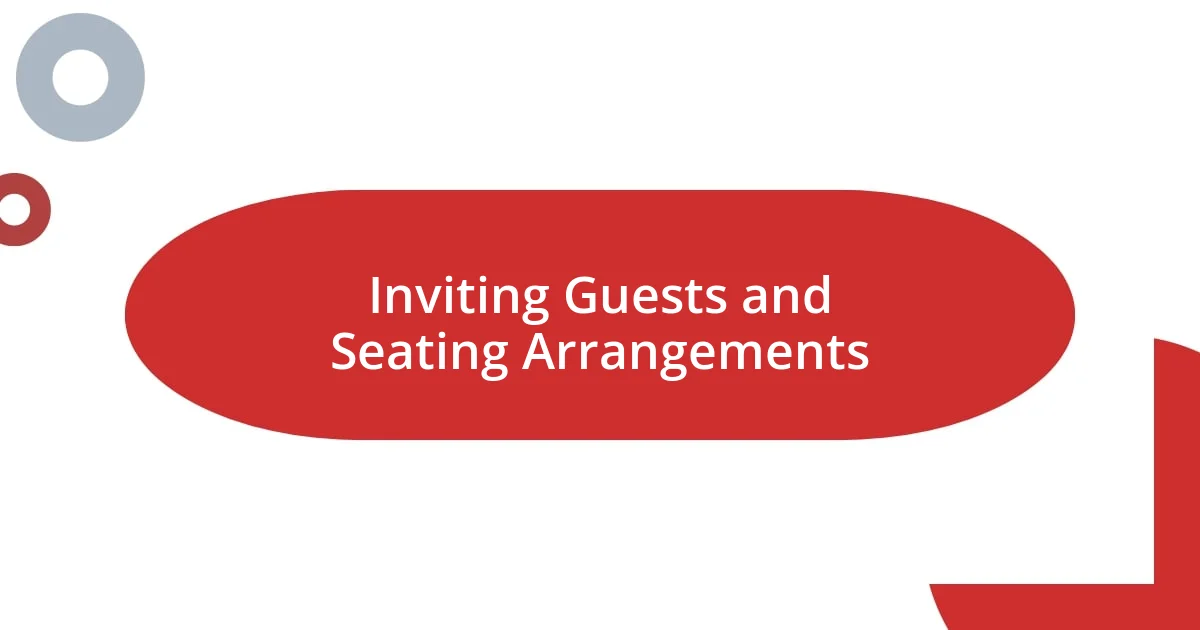
Inviting Guests and Seating Arrangements
Seating arrangements in Thai culture are dictated by hierarchy and respect. I remember attending a wedding banquet where the seating chart was carefully planned, ensuring that elders were placed at the head of the table. This attention to detail created an atmosphere of reverence, making it clear that every guest’s presence was cherished—something I deeply appreciated.
When inviting guests, it’s customary to extend the invitation warmly. I experienced this firsthand during a casual dinner with friends, where everyone was encouraged to bring someone along. The spontaneity of that invitation made the night feel alive, transforming a simple meal into a vibrant gathering full of laughter and storytelling. This practice teaches me the joy of community, as more guests always create a richer tapestry of conversation.
Understanding the intricacies of seating also involves acknowledging who sits where during the meal. Typically, the most honored guests occupy the seats closest to the host. I remember feeling a mix of gratitude and excitement when I was seated beside someone I greatly admired. This not only reinforced the practice of respect but also opened up enriching conversations.
| Seating Arrangements | Details |
|---|---|
| Hierarchy-Based | Guests are seated according to age and status, with elders occupying the most honored positions. |
| Warm Invitations | Inviting guests is often done with warmth, encouraging spontaneity and creating a lively atmosphere. |
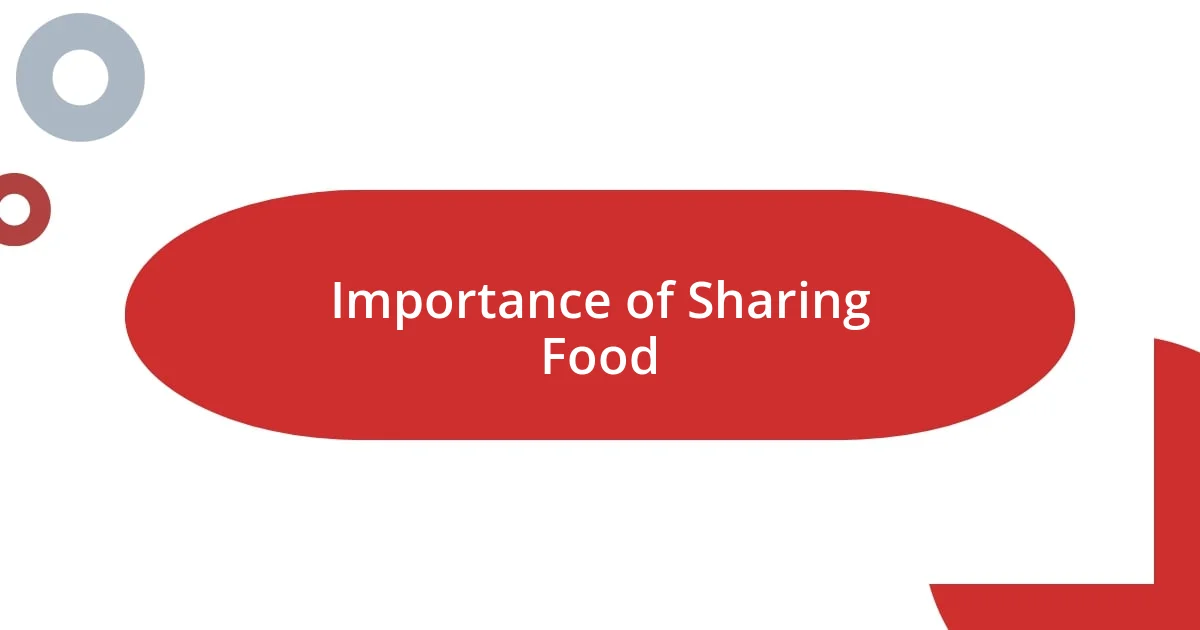
Importance of Sharing Food
When I first sat down for a traditional Thai meal, the concept of family-style sharing truly struck me. Dishes were abundant and placed in the center, inviting everyone to dig in. Have you ever noticed how, in sharing food, barriers seem to fade? I felt an immediate sense of connection with the others at the table as we passed plates around, laughter bubbling up with each dish.
There’s something special about sharing a meal; it not only nourishes the body but also fosters relationships. I remember nibbling on spicy green papaya salad while listening to a friend enthusiastically share a story about his travels. That communal act of reaching for the same food created a palpable bond—not just between us but with the vibrant culture of Thailand itself. Every bite I took felt like a celebration of connection and unity.
I’ve come to realize that food-sharing is more than a dining practice; it’s about generosity and connection. It’s a reminder that meals taste better when enjoyed collectively. One evening, while trying a delightful red curry, I found myself offering tastes to my neighbor, who immediately reciprocated with his favorite dish. What better way to learn about someone’s culture than through their food? Sharing transformed that meal into an exchange of experiences, one spoonful at a time.

Proper Use of Utensils
When it comes to using utensils in a Thai dining setting, I noticed that there’s a distinct etiquette that adds to the experience. In Thailand, forks and spoons are the stars of the show. The fork is often used to push food onto the spoon, which is then used for eating. I remember initially feeling awkward about this, but as I embraced the practice, I found it not only practical but also quite elegant. How fascinating is it that a simple method can enhance the act of dining?
One evening in a local restaurant, I noticed a couple at the next table expertly maneuvering their utensils. They made it look effortless! I found myself reflecting on how such precision in their movements elevated the meal; it was as if they were sharing an unspoken language of manners. This experience taught me respect—not only for the food but also for the traditions woven into each bite.
Also, I learned that using a knife at the table is less common in Thai cuisine, which surprised me at first. Instead of carving meat, everything is typically served in bite-sized pieces. I vividly recall enjoying grilled chicken skewers, simply lifting them from the plate with my spoon. This method felt intimate and inviting, creating a sense of belonging. Isn’t it interesting how something as simple as utensil use can reflect the heart of a culture?
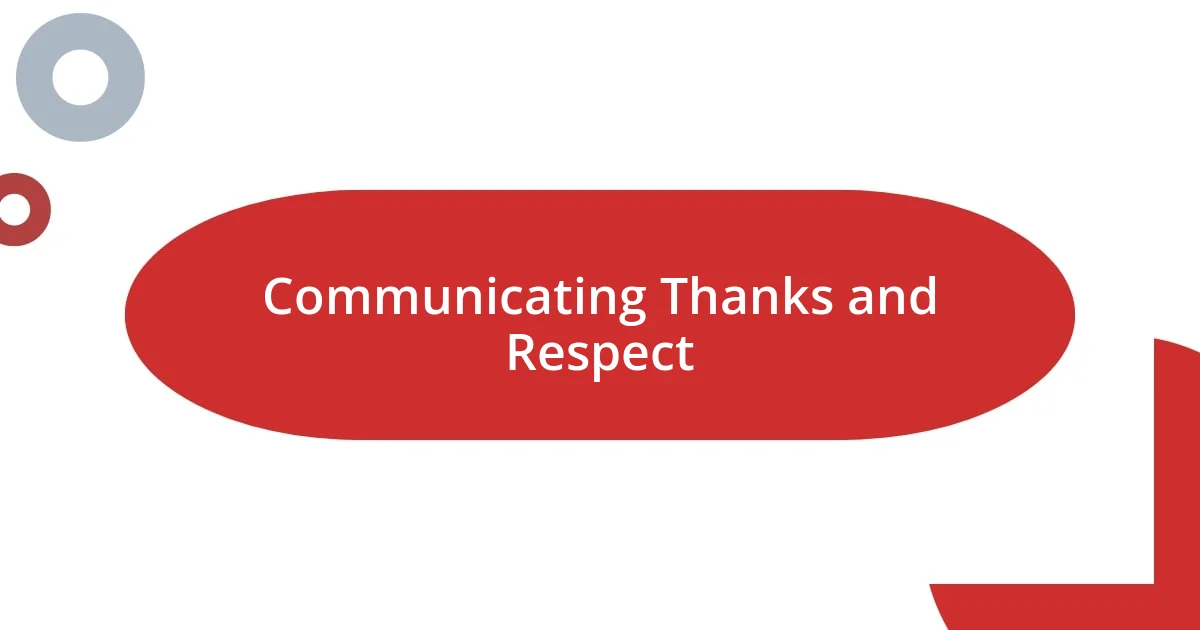
Communicating Thanks and Respect
Communicating thanks and respect in Thai culture is often expressed through simple yet profound gestures. For instance, a soft “khob khun” (thank you) goes a long way, and I’ll never forget the warmth in the eyes of the vendor as I expressed my gratitude after savoring a delicious bowl of tom yum soup. It made me realize that saying thank you isn’t just a formality; it adds a layer of connection to the experience, showing that I appreciate the care put into the meal.
I also learned that a slight bow or the gesture of bringing the palms together at your chest—known as “wai”—is a beautiful way to convey respect. The first time I offered a wai after enjoying a meal, I felt an unspoken bond form between me and the host. It’s a reminder that dining is not just about fulfilling hunger; it’s about acknowledging the relationship we build with each other and the effort behind the food.
What truly struck me was how these expressions are woven into daily interactions. One afternoon, while sharing a meal with locals at a bustling market, I watched how they effortlessly thanked each other and the vendors. This simple exchange was enriching; it lifted the dining experience into a realm of shared appreciation. Reflecting on this, I wondered—how often do we let such small acts of gratitude slip through? In Thailand, these gestures elevate the overall experience, enriching both the meal and the moment.
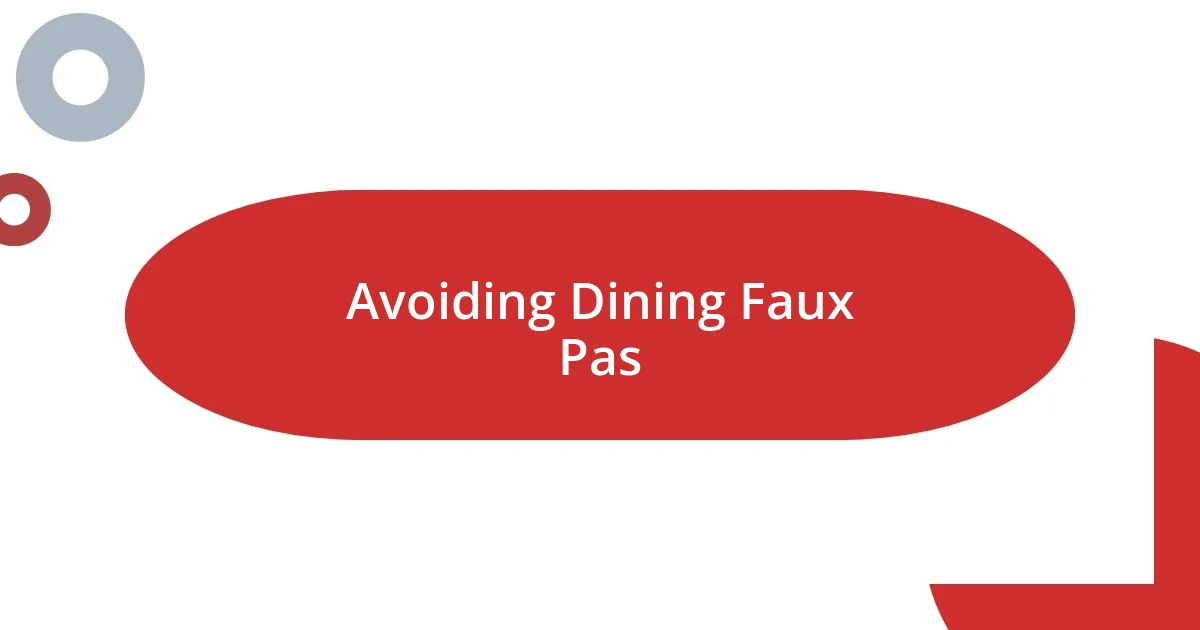
Avoiding Dining Faux Pas
One evening, as I sat down to a lovely Thai meal, I noticed how the locals ensured their phones were put away. At first, I felt a twinge of discomfort, wondering if I was missing out on snapping photos of my food. However, I soon realized that this practice truly fostered connection and presence among diners. Have you ever felt that tension between capturing the moment and being in it? I discovered that setting aside distractions allowed me to savor every flavor, and I felt more engaged with the people around me.
While dining, I also became aware of the importance of body language—it speaks volumes! Leaning back in your chair or crossing your arms can send the wrong signals, indicating disinterest or discomfort. But I fondly remember one meal where I actively participated in cheerful conversation, leaning slightly forward with a smile. This not only changed the mood but encouraged an inviting atmosphere. Isn’t it remarkable how our postures can influence the dining experience?
Then there’s the sensitive subject of commenting on the food. In Thailand, even a simple “It’s delicious” can be inappropriate if said too loudly or at the wrong moment. During one meal, I overheard a foreigner enthusiastically praising the curry without considering the table’s atmosphere. The sudden shift in attention felt jarring. I learned that timing and tone are everything; I began to appreciate the art of subtlety, allowing for genuine compliments at a more fitting moment. What lessons can we learn when we navigate this delicate dance of conversation during meals? It’s all about respect and understanding the dynamic of the gathering.










